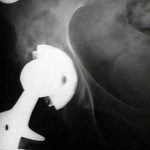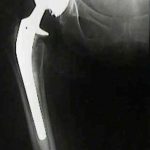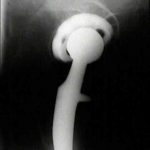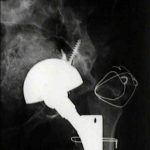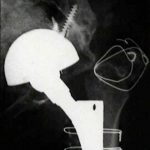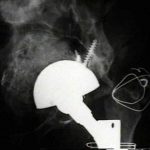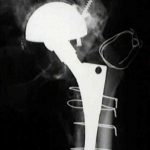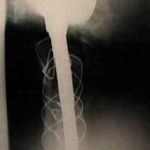(see also: acetabular component
Loosening of Press Fit Acetabular Components
(press fit acetabular components)
normal bone ingrowth
- generally for bone ingrowth to occur, the component must lie with 50 micrometers of the acetabulum, inorder for host bone ingrowth to occur;
- as noted by Bloebaum RD, et al (1997), bone ingrowth into component averages only 12%, even though 84% of the cup surface was in contact w/ periprosthetic bone;
- bone ingrowth was found to be uniform in all zones, most likely due to the uniform distribution of stresses from the metal backing;
- references:
radiographic signs of ingrowth fixation
(from Moore MS, et al.)
- 97 percent of the cups with three or more of these signs were determined to be stable at the time of revision surgery
- in contrast, 83% of the cups with two or fewer signs were loose.
- five radiographic signs of stable cup fixation:
- absence of radiolucent lines
- presence of a superolateral buttress
- medial bone stress-shielding
- radial trabeculae
- inferomedial buttress
- Radiographic Signs of Osseointegration in Porous-coated Acetabular Components.
radiographic signs of loosening
(see also: radiographic techniques for eval of acetabulum)
- radiolucent lines that initially appeared after two years
- The histology of the radiolucent line.
- progression of radiolucent lines after two years
- radiolucent lines in all three zones
- radiolucent lines 2 mm or wider in any zone
- migration
- loosening is present w/ more than 2 mm of migration (either horizontal or vertical);
- references:
- continuous radiolucent line;
- note that peripheral radiolucent lines which are non-continuous are commonly found in press fit acetabular components and are often not progressive;
- of note, postoperative gaps are net necessarily associated with subsequent presence of radiolucent lines, progressive radiolucent lines, or socket-loosening;
- reference:
other considerations
- consider presence of occult infection; (see infected total hip replacement)
- Is aseptic loosening of the prosthetic cup after total hip replacement due to nonculturable bacterial pathogens in patients with low grade infection?
Loosening of Cemented Acetablar Components
(cemented acetabular component)
- radiolucency upto 2 mm wide with or without a surrounding fine line of density may develop in one or more of the the three zones about cement mass in the pelvis;
- as in the femur, radiolucency is produced by the dense fibrous membrane and in some areas, fibrocartilage that forms about the surface of the cement and the surrounding shell of reactive bone;
- loosening commonly occurs at the stem cement interface, but it rarely occurs at the cup cement interface;
risk factors for loosening
- as noted by Kobayashi S, et al (1997), the most important factor for loosening is rapid wear of the polyethylene (more than 0.2 mm per year), followed by atrophic osteoarthritis (DJD w/o osteophytes);
definite loosening
- migration of component of more than 5 mm;
- crack in cement mantle;
probable loosening
- continuous radiolucent line > 1-2 mm wide at the bone cement interface;
- as pointed out by Hodgkins et al 1988, the finding of a continuous radiolucent line about the acetabular component indicates loosening in 94% of patients;
possible loosening
- non circumferential radiolucency which extends at least 50% around the bone cement interface;
implications of loosening
- even w/ radiographic loosening, only 10% of these hips will require revision;
Effect of Femoral Head Size
- higher frequency of isolated acetabular loosening was associated with use of a 32-mm femoral head.
- increased loosening rate of acetabulum w/ larger femoral head diameter may reflect thinner poly and higher frictional torsional stresses transmitted to the acetabular component;
- w/ smaller femoral heads, the frictional forces are less and the polyethylene is thicker
References
- Factors affecting aseptic failure of fixation after primary Charnley Total Hip Arthroplasty.
- Loosening of cobalt chrome beads from a porous-coated acetabular component. A report of ten cases.
- Total hip acetabular component position affects component loosening rates.
- Aseptic loosening in metal-backed acetabular components for total hip replacement. A minimum five-year follow-up.
- Bead loosening from a porous-coated acetabular component. A follow-up note.
- Early and late loosening of the acetabular cup after low-friction arthroplasty.
- Early failure of acetabular components inserted without cement after previous pelvic irradiation.
- A Comparison of Radiographic and Scintigraphic Techniques to Assess Aseptic Loosening of the Acetabular Component in a Total Hip Replacement.
- Radiographic Signs of Osseointegration in Porous-coated Acetabular Components.


